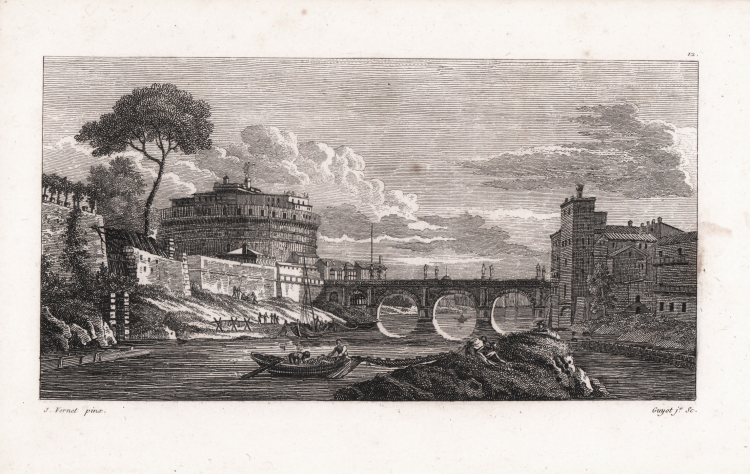


| Reference: | S46333 |
| Author | Laurent Guyot |
| Year: | 1805 |
| Zone: | Castel Sant'Angelo |
| Printed: | Paris |
| Measures: | 165 x 85 mm |


| Reference: | S46333 |
| Author | Laurent Guyot |
| Year: | 1805 |
| Zone: | Castel Sant'Angelo |
| Printed: | Paris |
| Measures: | 165 x 85 mm |
Veduta di Roma incisa da Guyot. Deriva dal celebre dipinto di Joseph Vernet.
Tavola tratta da Annales du Musée et de l'Ecole moderne des beaux-arts, Volume 17, di Charles Paul Landon e Vincenzo Giustiniani, stampato a Parigi nel 1805.
Acquaforte, in buono stato di conservazione.
|
Laurent Guyot (1756-1808) was an nngraver and print-publisher; b. and d. in Paris; first trained by Louis Claude Legrand and Jean Baptiste TIlliard. First established as a publisher in Versailles, rue des Bourdonnais; then moved to Paris c.1785 to 9 rue Saint-Jacques; in 1788 he moved to no.10 of the same street, and worked often in collaboration with the London publishers Merigot and Colnaghi (his pamphlet documents a visit to London at undefined point); in 1793 moved to 20 rue de la Monnaie; then in 1796 to rue des Mathurins, no.334, hôtel Cluny. Guyot used various techniques (etching, stipple, crayon manner, 'manière de lavis'...) and often printed his works using four plates (black, yellow, red, blue), although he seems to have opted for the 'à la poupée' method later in his career - when not discarding colour all together. Sometimes signs as 'Guyot Ainé'.
|
|
Laurent Guyot (1756-1808) was an nngraver and print-publisher; b. and d. in Paris; first trained by Louis Claude Legrand and Jean Baptiste TIlliard. First established as a publisher in Versailles, rue des Bourdonnais; then moved to Paris c.1785 to 9 rue Saint-Jacques; in 1788 he moved to no.10 of the same street, and worked often in collaboration with the London publishers Merigot and Colnaghi (his pamphlet documents a visit to London at undefined point); in 1793 moved to 20 rue de la Monnaie; then in 1796 to rue des Mathurins, no.334, hôtel Cluny. Guyot used various techniques (etching, stipple, crayon manner, 'manière de lavis'...) and often printed his works using four plates (black, yellow, red, blue), although he seems to have opted for the 'à la poupée' method later in his career - when not discarding colour all together. Sometimes signs as 'Guyot Ainé'.
|